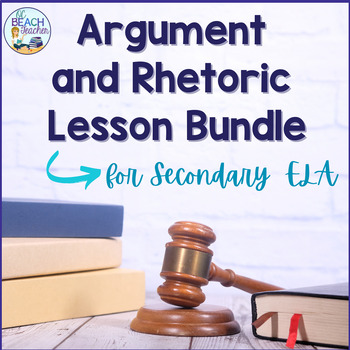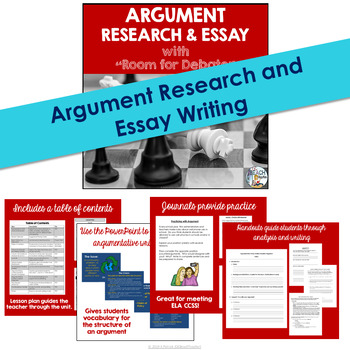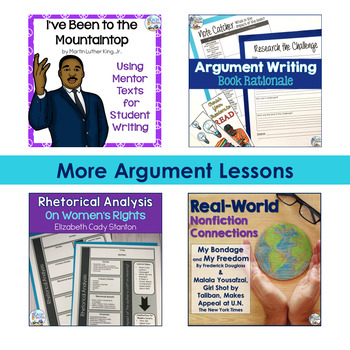Argument and Rhetorical Analysis Lesson Bundle - Close Reading and Essay Writing
- Zip
- Easel Activity
Products in this Bundle (16)
showing 1-5 of 16 products
Description
These lessons and activities make teaching argumentative writing and rhetorical analysis easy! Use argument writing bell ringers, an argument research essay unit, rhetorical appeals task cards, research activities, paired texts, graphic organizers, and a rhetorical appeals trashketball game to differentiate instruction and meet the needs of individual students. These fourteen varied activities and lessons also help improve reading comprehension and prepare students for standardized assessments.
Argument Writing Bell Ringers
Give students practice with argumentative writing with these bell-ringer handouts that require them to consider evidence for claims, brainstorm counterarguments, and provide possible refutation. Each handout starts with an engaging topic for adolescents, including some of the following: vaping, distracted driving, electronics in class, the high school dropout age, cyber bullying, college entrance exam requirements, learning to code, drug testing student athletes, recycling in schools, lowering the voting age, banning pit bulls, requiring preschool, paying college football players, forgiving student loan debt, banning promprosals, bringing pets to work, regulating drones, vaccinating children, and others.
Argument Research Essay Unit
Make writing argument essays relevant with this month-long unit! Students begin by reading, analyzing, and evaluating articles on real-world topics from “Room for Debate" in The New York Times. Then, using their reading as inspiration, students select a topic for research and use their research to write a formal argumentative essay. Throughout the unit, the teacher scaffolds instruction and provides practice paraphrasing, avoiding plagiarism, MLA formatting, and developing arguments. The teacher also guides students through the writing process as they outline, draft, revise, and write their final essays.
Revision Task Cards for Argumentative Writing
Use these task cards to guide students through the revision of their argument essays for ideas, organization, word choice, voice, fluency, conventions, presentation, and academic integrity. Revision is often one of the most challenging steps in the writing process, but this resource makes the task interactive, collaborative, differentiated, and reflective.
Rhetorical Appeals Task Cards
Extend student understanding of ethos, logos, and pathos with this activity that directs students to use rhetorical appeals in their own words. Over 30 varied topics use real-world connections and relevant issues to engage secondary students. When students use rhetoric in their writing, they gain a better understanding of their analysis and reading of arguments. In addition to using the prompts, students can write their own claims and points of view with the blank template.
Rhetorical Appeals Trashketball
This interactive game helps students review rhetorical appeals (ethos, logos, and pathos) in the context of classic speeches and texts. Texts referenced include Sojourner Truth’s “And Ain’t I a Woman?”, Patrick Henry’s “The Speech to the Second Virginia Convention,” Elizabeth Cady Stanton’s “On Women’s Rights,” and an excerpt from Frederick Douglass’s My Bondage and My Freedom.
In the game, there are four rounds. In each round, the students must identify the examples from the texts as ethos, logos, or pathos. Additionally, they must provide short explanations for their answers. Students compete to shoot baskets into your classroom trash can! All that you need to play is the ability to project a PowerPoint presentation, a soft ball, dark tape, and a trash can. You may want to encourage students to take notes during the review slides at the beginning of the presentation.
Argument Writing: Book Rationale
In this engaging lesson, students use argumentative writing to provide a rationale for the study of banned or challenged books. Students participate in a short research activity to discover the charges against the books, then use a note catcher graphic organizer to help them identify text examples that demonstrate the educational value of their books. They annotate for life lessons, character connections, pathways to understanding, and real-world relationships. After gathering their text evidence, students are guided through the writing process with a series of handouts, eventually completing an argumentative essay. This resource also includes a fun bookmark extension activity.
Paired Texts: Civil Disobedience and The Great Debaters
In this lesson, students complete close readings of an excerpt from Henry David Thoreau’s “Civil Disobedience” and the debate scene “Wiley College vs. Harvard University” from the movie The Great Debaters (which can be used with or without viewing the movie). Then, they synthesize their understanding of the readings and write a short analytical essay requiring them to analyze the arguments in the texts.
Paired Texts: We Shall Overcome and Second Inaugural Address
In this lesson, students complete close readings of Lyndon B. Johnson's speech "We Shall Overcome" and Abraham Lincoln's "Second Inaugural Address." Then, they synthesize their understanding of the readings and write a short analytical essay requiring them to analyze the arguments in each speech. Use this lesson to give your students practice with close reading and the synthesis of ideas. Activity handouts focus on before-, during-, and post-reading strategies and culminate in a short essay, which asks students to consider why education may be limited for certain groups of people.
Paired Texts: Preamble, Bill or Rights, Speech by Ruth Bader Ginsburg
In this lesson, students complete close readings of the Preamble to the Constitution, the Bill or Rights, and a speech by Ruth Bader Ginsburg. Then, they synthesize their understanding of the texts and write a short analytical essay requiring them to analyze a central idea.
Paired Texts: Speech to the Second Virginia Convention and "The War Prayer"
Guide your students through close readings of two classic texts: “Speech to the Second Virginia Convention” by Patrick Henry and “The War Prayer” by Mark Twain. Then, facilitate their understanding of the speakers’ attitudes and central themes as they construct connections between the texts and write an analytical essay.
Nonfiction Connections: from My Bondage & My Freedom and New York Times Article
This lesson connects three texts: Robert Hayden’s poem “Frederick Douglass,” an excerpt from Frederick Douglass’s My Bondage and My Freedom, and the New York Times article “Malala Yousafzai, Girl Shot by Taliban, Makes Appeal at U.N.” This lesson makes learning relevant for your students through real world connections, while also meeting expectations of the Common Core Curriculum by employing rigorous nonfiction texts.
Martin Luther King, Jr. Speech Writing Lesson
Make your study of Martin Luther King, Jr. a literacy lesson with a primary source. Students complete a close reading of Dr. King's prophetic speech “I’ve Been to the Mountain Top” and use their reading as inspiration for their own writing. With Inspired Writing, students use mentor texts as models for their own writing.
Rhetorical Analysis "On Women's Rights"
Make real-world connections with this argument analysis activity using the speech, "On Women's Rights," from Elizabeth Cady Stanton. The rhetorical analysis graphic organizer guides students through analysis of rhetorical features including diction (word choice), rhetorical appeals (ethos, logos, pathos), structure, author’s craft and purpose, tone, and central ideas (themes). This scaffolded approach to rhetorical analysis provides an alternative to the widely-used SOAPStone strategy.
If desired, all of these lessons and activities are available separately. Two free bonus lessons are also included!
Meaningful and Memorable English Language Arts by © OCBeachTeacher ™
All rights reserved by author.
Limited to use by purchaser only.
Group licenses available.
Not for public display.





